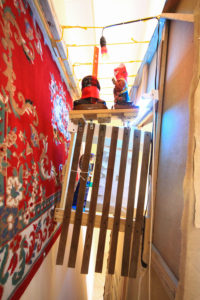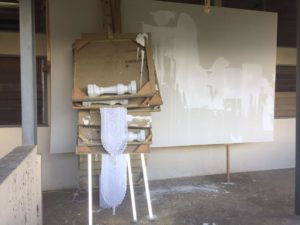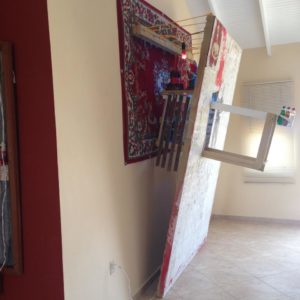
To him the back (of a painting) is more than a coincidental narrative; it probably even forms the plot of the story. Because Martha actually plays with space in all his works, you could call the work an example of this. But it is more. He is opening a discussion on painting as a genre and so relegating the current terminology – painting, sculpture, installation, etc. – to the past.
Rob Perrée on the art of Tirzo Martha, from Curacao.
The backside of a painting
Our exhibition program aims to present our collection of seventeenth-century paintings in new and inspiring ways, and to share this with our audience. The collaboration with Vik Muniz is an outstanding example. The Verso series establishes a meaningful link between the contemporary art of Vik Muniz and the Old Master paintings in the collection of the Mauritshuis.
*
This quote is from Emilie Gordenker, director of the Mauritshuis in The Hague. In 2016 the museum exhibited five works by the Brazilian artist Vik Muniz, five life-size prints of the backs of paintings by famous Old Masters. For Muniz the backs have their own story, which thereby provides a unique link to the front. There are holes in them, labels have been stuck on and they have been stamped, there is sometimes a rejected painting here, sometimes a carrier or museum has left its administrative tracks, there is sometimes a date, from which the history of the work can often be traced. It is in any case possible to establish the material with which and from which it has been made. The hidden nature of the back means that it may well form the most intimate part of the masterwork. For the viewer it is a unique, slightly alienating experience, since he has been conditioned to only look at the front. The back only reveals itself to carriers, technical organizers and curators.
*
This presentation brought to mind the work of Tirzo Martha.
*
Martha generally makes installations, often large, in which he combines all kinds of objects that play a role in everyday life into a fanciful construction, which sometimes has the air of an architectural structure. Because the relationship between the various components does not point to an immediate interpretation, the work forms an exciting, intriguing whole. The components vary from toilet pans to religious statues, from parasols to mirrors, from carpets to swimming aids and from wheelbarrows to oil drums. They are frequently used symbolically and this symbolism is responsible for the interpretation the viewer is able to give to the work. Sometimes the works can be read as self-portraits, more often they question the attitude of the average Curacaoan – and, at a universal level, the inhabitants of many former colonies. Why does he play the role of the victim? Why does he turn to the culture of Europe and the United States and indiscriminately lay out the red carpet for the commercial tourist industry? Why does he allow himself to be manipulated by religions? Why does he not seek out his own identity and open himself up to the riches of his own culture?
*
This installation is often created on location, making use of the resources readily available at that specific spot. This is partly for practical reasons, but it certainly also has to do with the need to make a substantial connection with the immediate vicinity. When the work finally arrives in the exhibition space it is set up so that the viewer can walk round it and see it from all sides.
In recent years there has been a shift in Martha’s work. Whether this is a supplementary way of working or a new one is not yet clear. The subject matter has not really changed, but the formal aspects of the work play a greater role and the location at which it is realized is more and more often his studio on Curacao. A causal connection is thereby quite possible.


The Consequence Of Giving Me Carte Blanche At Plein Air (2016)
The first time that painting stirred Martha’s imagination was when, as a child, he attended meetings of the Jehovah’s Witnesses, the faith in which he was brought up. Nowadays they are almost certainly livened up with huge screens, in those days it was a mural painted on the back wall. In the enticing, figurative style that was used to paint the early cinema advertisements. This arousal of the imagination has become the motif for his career; painting, however, did not become his medium of choice.
And yet for a few years now painting has indeed played a role in his work.
*
This work – The Consequence Of Giving Me Carte Blanche At Plein Air (2016) – undeniably proves the point. White paint has been applied to the background. Rough brush strokes painted in a seemingly random and uncontrolled manner. They are not easy to describe using any of the familiar jargon. Certainly not figurative, but the term abstract is not suitable either. To the left a stack of stretched but empty canvases leans against the background. Their backs are to the viewer. On these lie three coffee table legs, painted white. Stuck between the canvases a couple of (artificial) lace doilies hang down. The whole thing can only be referring to the art of painting. Paint and canvas are after all the basic materials. This is confirmed by the fact that the whole thing does not stand in the space as an installation but is inclined against the wall. In addition the title refers to a 19th century development in painting.
*
What is happening here?
*
In his work Martha frequently responds to the ongoing hegemony of the West over ‘the Rest’, as Kitty Zijlmans puts it in her piece for this book. (1) She shows that his self-portraits – collections of objects that have something to do with his life – challenge this hegemony. Is this ‘painting’ a headstrong and original response to the tradition of Western art? Is he turning a painting into one of the objects that together form an installation, in which each object is a reference, whether or not symbolic, to everyday life? Does his ‘slapdash’ use of household paint provide an ironic undertone of his implicit attitude or is it a case of provocation?

My interpretation of Red, 2016.
My interpretation of Red from 2016 is another example of a ‘painting’. The work appears to have been made on the back of a painting. The attachments and the frame point to a canvas stretcher. The artist has signed and dated the work as is commonly done on the back of a painting. There is no normal front side. He has drenched the objects in red paint and put splodges of red paint on the background. Just as with the work described above, this objectifies the paint and turns it into a component of equal value to the entirety of objects. The most notable reference to painting is of course the deliberate use of the color red and the suggestion that this color is open to more than one interpretation. Almost all of Martha’s works are collections forged into one whole without the various components completely losing their (original) identity. In this work the artist is choosing to neutralize the individual identities. This is exceptional. The fact that the object in the middle displays human features gives food for thought, particularly because the artist is literally restraining the ‘person’. Does this stand for the constraint of the code that protects the Western canon against influences from the Rest? For creative colonialism?


The Reinvention of the Ananzi Colonialism, 2014.
The Reinvention of the Ananzi Colonialism from 2014 also contains only too obvious references to either the art of painting or to the painting. The painting method is slightly different. The paint has been applied in a more Ryman-like way. Less random, more careful, more strategic. The ‘canvas’ has been brutally disrupted by an extension that ends in liquor bottles. The photographic images adapt themselves more naturally to their background. They fit in better with the expectations that the average viewer has for a painting.
*
What is remarkable in this work is that Martha thought it necessary to give the ‘painting’ a special back side. Besides the carpet hanging behind it, an inviting symbol he often uses, objects have also been placed that require attention in order to understand the whole. Two statuettes laced up with tape, a black Jesus and a ‘Negro Pio’ who is literally being held to a yardstick stand on an elementary platform. Underneath these a white angel (Raphael?). It takes a second look for the viewer to realize that the extension on the front leads through to another part of the story at the back. Just as the above-mentioned works by Muniz have an alienating effect because he invites the viewer to look at the hidden side of a famous painting, so Martha misleads the viewer by sending the viewer to the back of his work like some kind of voyeur. In contrast to his Brazilian colleague, Martha makes the back into a component of the front. To him the back is more than a coincidental narrative; it probably even forms the plot of the story. Because Martha actually plays with space in all his works, you could call the work an example of this. But it is more. He is opening a discussion on painting as a genre and so relegating the current terminology – painting, sculpture, installation, etc. – to the past. He is also inviting the viewer to reconsider his accustomed viewing habits. Justifiably a Reinvention, disassociating oneself from the Ananzi Colonialism.
*
Over recent years Tirzo Martha has created more and more works in his studio spaces on Curacao. There are probably practical reasons for this – more suitable space, easier since everything is close by, more and less hectic production time, etc. – but it also has to do with the development his work is undergoing. As a rule these are installations that he sets in a space so that everyone can look at them from all sides, mostly built up from a multitude of objects with a symbolic or otherwise emotional connotation, but in recent years he has produced works that are less busy, less full, which are still indebted to his subject matter, but which appear to be paying more attention to formal aspects. Is he concentrating more on this in order to hold his own more effectively, slightly more directly against the Western canon where the painting still takes center stage? Is he (temporarily) reserving his alter ego Captain Caribbean for spreading his message and meanwhile chiefly concentrating on the process and the refinement of the presentation forms? There is not yet any clear answer to these questions.
The fact that he chooses to more or less reconstruct his studio situation for his presentation in the Beelden aan Zee museum (2), indicates that a shift in priorities has taken place.
